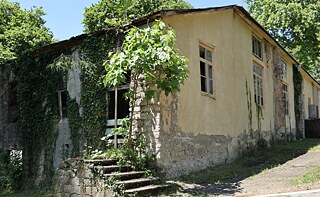Chokhatauri
The physical mapping process for the municipality included both theoretical and practical aspects for two months. Experts, along with the educational component of the developed mapping methodology, mentored the municipality’s working group through each step of the process.
A detailed list of buildings and spaces was created. To collect information about these objects, research was conducted through inter-sectoral cooperation, fieldwork, and photofilming. The gathered data was then analyzed and recorded on a digital map, and the results were presented.
A detailed list of buildings and spaces was created. To collect information about these objects, research was conducted through inter-sectoral cooperation, fieldwork, and photofilming. The gathered data was then analyzed and recorded on a digital map, and the results were presented.
Physical Mapping Results
In Chokhatauri Municipality, out of the 34 listed properties, 44% are cultural institutions, and 26% are administrative buildings. Educational and industrial infrastructure each account for 6%, while Retail infrastructure represents 6%, and sports facilities make up 3%.
The usage of listed properties follows as 15% in active use, 18% partially utilized, and 67% are nonfunctional.
The structural condition of the mapped buildings is - 56% are structurally stable, 3% have been rehabilitated, 15% show minor damage, and 26% are severely damaged.
The ownership of these properties is distributed as follows: 17% are privately owned, 24% are state-owned, 56% are municipally owned, and 3% are unregistered.
Notable buildings include The Cultural House of Shua Amagleba Village, the Cultural House of Amagleba Village, the Cultural House of Jvartskhma Village, the Cultural House of Sakvavistke Village, the Cultural House of Bukistsikhe Village, the former Kolkhoz building of Jvartskhma Village, the cinema building, the former Tea Factory No. 1, the former Industrial Technical School of Goraberezhauli (Building No. 1), the former Industrial Technical School of Goraberezhauli (Building No. 2).
The usage of listed properties follows as 15% in active use, 18% partially utilized, and 67% are nonfunctional.
The structural condition of the mapped buildings is - 56% are structurally stable, 3% have been rehabilitated, 15% show minor damage, and 26% are severely damaged.
The ownership of these properties is distributed as follows: 17% are privately owned, 24% are state-owned, 56% are municipally owned, and 3% are unregistered.
Notable buildings include The Cultural House of Shua Amagleba Village, the Cultural House of Amagleba Village, the Cultural House of Jvartskhma Village, the Cultural House of Sakvavistke Village, the Cultural House of Bukistsikhe Village, the former Kolkhoz building of Jvartskhma Village, the cinema building, the former Tea Factory No. 1, the former Industrial Technical School of Goraberezhauli (Building No. 1), the former Industrial Technical School of Goraberezhauli (Building No. 2).






